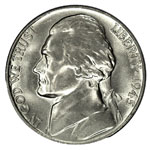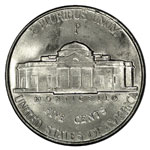
Grading Jefferson Five Cents (1938-Date)

|

|
| Click to enlarge | |
As one of our current circulating coin types the Jefferson nickel doesn't receive a lot of publicity and seldom is the focus of numismatic articles. Also, there are no rarities within this long series, as the practice of saving uncirculated rolls of each new date/mint combination was firmly established when the Jefferson type was introduced in 1938. That's not to say, however, that these coins offer nothing to collect. There are countless interesting varieties, such as the overdate 1943/2-P and several overmintmarks (1954-S/D and others), as well as a wide variety of error types. Collectors find the regular sequence of date/mint issues appealing because a mint state collection can be completed at reasonable cost.
Grading Jefferson nickels is an activity limited mostly to mint state coins, as only a few dates carry premiums in circulated condition. It seems that nickels from the 1930s and '40s are more likely to have survived in high grades than those coined during the 1950s and ‘60s, at least in relation to the numbers saved. Gems of issues since 1968 are plentiful from the Mint's annual uncirculated sets sold to collectors, though fewer rolls were set aside after 1964. The earlier dates seem to have been made with more care and appear to have suffered less tumbling about at the mints and during shipment to banks than those from the mid years of this series. Early Jefferson nickels also are more likely to be found well struck than are later dates through the '60s. Most mint state Jeffersons are highly lustrous, and the San Francisco Mint coins of the 1940s and early '50s are sometimes quite prooflike from repolished dies.
When arriving at a grade for a Jefferson nickel, graders consider its luster (very important)k, the number and location of contact marks (also critical), toning, if any (of lesser importance) and, finally, sharpness of strike (perhaps least important, except with respect to the steps of Monticello). An intangible quality, one often voiced by experienced collectors and dealers, is "eye appeal." Difficult to define in words, it combines all of the above elements and is vital in evaluating modern coins, as many look alike on first inspection.
Since choice and gem examples of all dates are plentiful, Jefferson nickel enthusiasts have seized on another feature of the coin's design to separate superior pieces from less desirable ones. Collectors have long noted that not all the steps of Monticello (Jefferson's home depicted on the reverse) are visible on most coins. This design element is the deepest cavity in the reverse die, and it is opposite another deep cavity in the obverse die. Both conditions weigh against the planchet metal being compressed sufficiently in a single blow from the press to fill the dies completely. It is even possible that some dies were themselves not hubbed sufficiently to show full steps, meaning that coins struck from them didn't stand a chance.
The frequency of full steps varies from one date to the next, but there are some familiar patterns. A date such as 1940-D is often seen with full steps, while a 1960-D nickel is quite rare in this condition, though average examples were widely hoarded in mint state. It is nearly impossible to complete a collection in which every coin displays a full complement of steps from one side of the stairway to the other, but plenty of cherrypickers still try.
NGC utilizes two designations to reflect the relative degrees of fullness in these steps: 5FS indicates that five of the six steps are complete, while 6FS is a rare designation reserved for those coins displaying six, uninterrupted steps. The presence of full steps on a nickel does not affect its numerical grade at all, and gems can exist both with and without this additional asset.
Numerous modifications have been made to the master hubs of the Jefferson nickel, perhaps the most obvious occurring in 1971. While not a big issue in grading, these changes affect the overall relief of the coins and can affect their quality of strike and luster, as well as their susceptibility to contact marks. Jeffersons coined in since the late 1980s typically are in lower relief than earlier issues but have all details fairly sharp. The various changes to the design of the nickel since 2004 have continued this trend of low relief, which minimizes erosion to the dies and extends their useful lifespan.
From One to Seventy originally ran in The Numismatist, official publication of the American Numismatic Association (www.money.org)
Enjoy the article? Use the bookmark tool to save or share it.
![]()
Return to the Coin Grading Guide - From 1 to 70